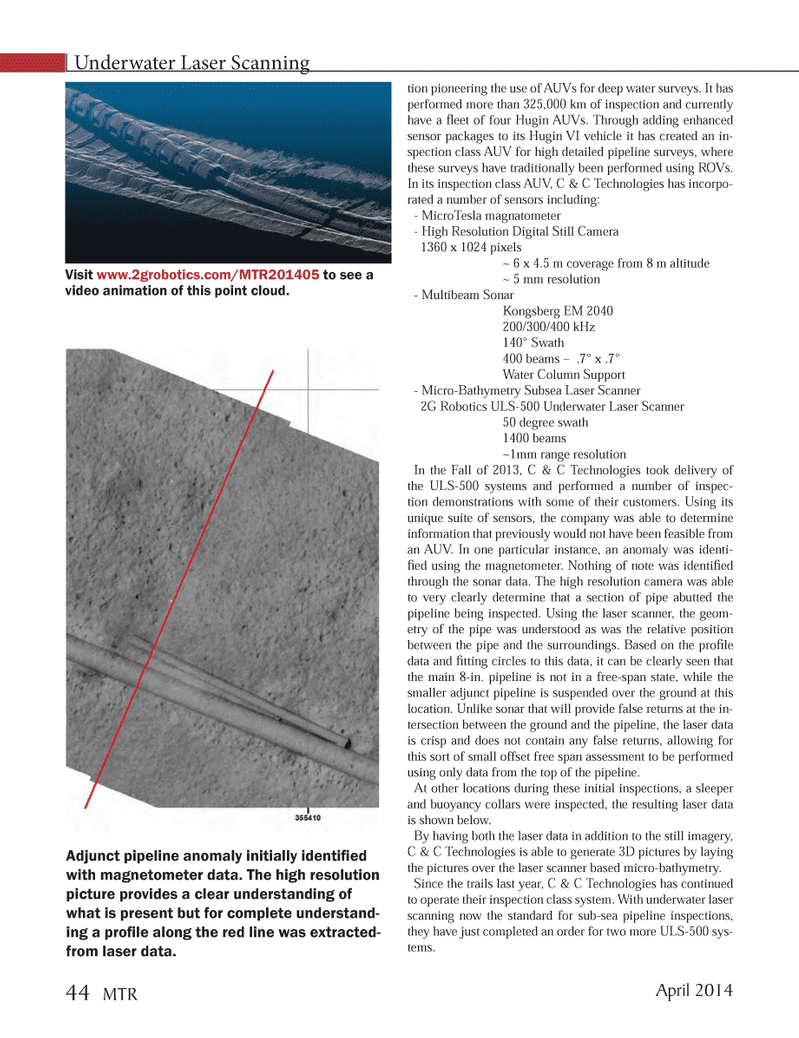
Page 44: of Marine Technology Magazine (April 2014)
Offshore Energy
Read this page in Pdf, Flash or Html5 edition of April 2014 Marine Technology Magazine
Underwater Laser Scanning tion pioneering the use of AUVs for deep water surveys. It has performed more than 325,000 km of inspection and currently have a fl eet of four Hugin AUVs. Through adding enhanced sensor packages to its Hugin VI vehicle it has created an in- spection class AUV for high detailed pipeline surveys, where these surveys have traditionally been performed using ROVs.
In its inspection class AUV, C & C Technologies has incorpo- rated a number of sensors including: - MicroTesla magnatometer - High Resolution Digital Still Camera 1360 x 1024 pixels ~ 6 x 4.5 m coverage from 8 m altitude ~ 5 mm resolution - Multibeam Sonar Kongsberg EM 2040 200/300/400 kHz 140° Swath 400 beams – .7° x .7° Water Column Support - Micro-Bathymetry Subsea Laser Scanner 2G Robotics ULS-500 Underwater Laser Scanner 50 degree swath 1400 beams ~1mm range resolution
In the Fall of 2013, C & C Technologies took delivery of the ULS-500 systems and performed a number of inspec- tion demonstrations with some of their customers. Using its unique suite of sensors, the company was able to determine information that previously would not have been feasible from an AUV. In one particular instance, an anomaly was identi- fi ed using the magnetometer. Nothing of note was identifi ed through the sonar data. The high resolution camera was able to very clearly determine that a section of pipe abutted the pipeline being inspected. Using the laser scanner, the geom- etry of the pipe was understood as was the relative position between the pipe and the surroundings. Based on the profi le data and fi tting circles to this data, it can be clearly seen that the main 8-in. pipeline is not in a free-span state, while the smaller adjunct pipeline is suspended over the ground at this location. Unlike sonar that will provide false returns at the in- tersection between the ground and the pipeline, the laser data is crisp and does not contain any false returns, allowing for this sort of small offset free span assessment to be performed using only data from the top of the pipeline.
At other locations during these initial inspections, a sleeper and buoyancy collars were inspected, the resulting laser data is shown below.
By having both the laser data in addition to the still imagery,
C & C Technologies is able to generate 3D pictures by laying the pictures over the laser scanner based micro-bathymetry.
Since the trails last year, C & C Technologies has continued to operate their inspection class system. With underwater laser scanning now the standard for sub-sea pipeline inspections, they have just completed an order for two more ULS-500 sys- tems.
Adjunct pipeline anomaly initially identifi ed with magnetometer data. The high resolution picture provides a clear understanding of what is present but for complete understand- ing a profi le along the red line was extracted- from laser data.
Visit www.2grobotics.com/MTR201405 to see a video animation of this point cloud.
April 2014 44 MTR
MTR #3 (34-49).indd 44 4/9/2014 11:02:44 AM

 43
43

 45
45
